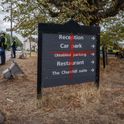The history of Ireland and Northern Ireland is littered with violence occurring around the Twelfth of July. There was rioting in 1857 that lasted for ten days. The most horrific in my memory happened in 1998. During the height of the Drumcree standoff the UVF threw a firebomb at a family who lived in a Protestant estate. The mother was Catholic but she’d raised her three boys as Protestant. All three boys died in the fire.
In recent years, things have changed. The situation isn’t perfect, but things have improved. The Twelfth went so well last year it was called a “model for years to come.” Parades that would once have caused days of trouble went by unnoticed.
Things were a bit different this year.
In scenes that gave people flashbacks to the past, the days leading up the Twelfth were violent. In Londonderry/Derry petrol bombs were thrown at the Protestant Fountain Estate and shots were fired at police officers. Tensions were so bad that every mainstream party issued a statement calling for calm.
On the July 11, cars and a bus were hijacked and burned in parts of East Belfast. Belfast City Airport was closed because of a suspicious device that thankfully later turned out to be a hoax.
What caused the trouble?
It’s not clear why trouble flared this year when things went so well in 2017. The PSNI said on July 11 that the East Belfast UVF intended to “orchestrate and participate in serious disorder.”The violence also came after the High Court in Belfast ordered a controversial bonfire to be reduced in height. Another bonfire in East Belfast was taken down completely.
It might seem bizarre that this could be an issue—but it’s rare to see such scenes.
Coverage in England
It’s no surprise that none of this got a lot of coverage. All this happened just as England lost their World Cup semi-final against Croatia. Trump is currently in the UK for a visit, and the Government published its Brexit White Paper on July 12.When presenters on the TV mentioned the trouble it was with an air of, “There they go again. Same old, same old.”
I doubt they’d be as relaxed if police officers were getting pelted with petrol bombs in London, but normality tilts on its axis when it comes to us.
A difficult history
There are certainly difficult conversations to be had about the Twelfth of July, particularly its history.Pictures of bonfires baring bigoted, violent slogans still make an appearance—and did so this year, with one bearing the legend “Kill all taigs,” a derogatory term for Catholics.
One video went viral of a group of young people attending a bonfire singing “We hate Catholics” to the tune of Tiffany’s “I think we’re alone now.”
A cross-community football team, St James’ Swift, were aghast when flags from their club were stolen and placed on top of a bonfire.
There’s still a lot of work to be done. Difficult, uncomfortable conversations need to happen within unionism, and making the Twelfth commercially friendly isn’t enough.
Peace is a process
It would be great, however, if the positives were given as much coverage as the negatives. Peace is a process, as the saying goes, and amidst the violence of the past few days there was progress.So many problems in Northern Ireland are centred on culture and emblems. To tackle the problem you have to ask how a divided society manages its differences.
I don’t celebrate the Twelfth but it is important to people, particularly working-class Protestants. Should we eradicate opposing identities, or should we be comfortable with them? Despite the headlines over the past few days, it is the latter seems to be happening.
Cross-community efforts
In recent weeks, the Republic of Ireland’s Taoiseach Leo Varadkar paid a visit to the Orange Museum in East Belfast.Former Ireland Captain Brian O’Driscoll, a Catholic from Dublin, was in Armagh on the 12th this year and had a go playing a Lambeg drum—a type of instrument used by Unionists and the Orange Order in the parades.
The Minister for Tourism and Sport in the Republic of Ireland, Brendan Griffin, visited the Twelfth Parade in Belfast. He’s the first minister from the Republic to do so.
https://twitter.com/BBCNewsNI/status/1017401600011325440
Unionist leaders have also reached out in recent weeks, with Arlene Foster attending the Ulster GAA final on June 24—the first time a senior unionist politician has attended such a game since 2012—as a gesture towards a “shared society.”
These sort of cross-community efforts helped ensure the parades themselves were as peaceful as last year.
Challenging sectarian narratives
It is taboo in some places to call out sectarianism and challenge narratives but some people are doing so within their communities. We should be supporting them.On the Eleventh Night, friends of mine tweeted pictures of their local bonfires that were free from emblems and sectarian slogans. Many families and young people went out and enjoyed their day.
There’s a story from the past few days that stands out for me. A friend on Twitter, from a Catholic/Nationalist background, tried to travel across Belfast to celebrate the Twelfth with a Protestant friend. She couldn’t do so because the roads were blocked because of the violence.
It’s a metaphor for how violence and sectarianism can damage and hinder progress. But it also shows that, in small ways, people are moving forward.













